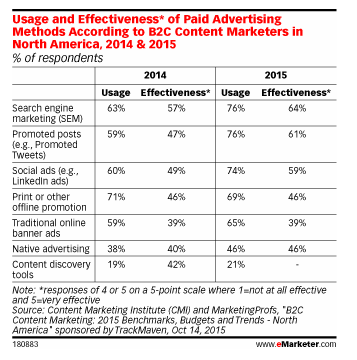Pay Attention to FTC Content Guidelines!
Today I noticed an eMarketer article with the headline “Many B2B Marketers Not Aware of FTC Sponsored-Content Guidelines” and under the headline was a sub-headline “Content marketing spending is expected to increase”, which seems to be a pretty big issue for business-to-business companies doing digital marketing.
The article cited a the 2015 benchmark survey by CMI and MarketingProfs in August that suggested that only 8% of B2B marketers felt comfortable with their understanding of FTC guidelines about public disclosure of sponsored-content compensation, but 51% of B2B marketers in North America are planning to increase their content marketing. In addition, 64% of them have used content marketing, and half of them have used sponsored social marketing.
Another interesting point from the Content Marketing Institute and MarketingProfs 2015 benchmark was that promoted posts and social ads were the most effective marketing methods after search engine marketing.
It makes sense that companies, and not just B2B, are gearing up to use social media and content advertising. If that is the case, it makes sense to review the FTC guidelines for social media again before creating content for these sponsored posts and ads.
In May of 2015 the FTC updated a FAQ sheet referring to truth in advertising guidelines to better define the standards for endorsements, in particular, endorsements made digitally. The main standout points that are important for B2B advertisers using content marketing on social media are:
- Disclose any arrangement, relationship or deal made with the content publisher, no matter how seemingly insignificant.
- Guides were designed to help explain whether social media endorsements violate Section 5 of the FTC Act, which allows them to investigate deceptive advertising. Read the guides.
- It is important to continually mention the endorsement parameters even if they were mentioned in a prior blog post or article because the viewer may not have seen them, or also mention them in individual posts even if they are displayed on the home page of a site.
- Even a picture of a product is considered a positive endorsement and has to be qualified.
- In general, disclosures should be very evident. They should be:
- Located physically near the claims to which they relate;
- Written in a font and color that is easy to read;
- On a video screen long enough to be read, and understood;
- Read slowly enough for consumers to follow and in words consumers will understand if done with an audio.
- The FAQ further specifies that “Disclosures should not be hidden or buried in footnotes, in blocks of text people are not likely to read, or in hyperlinks.”
- When asking for reviews, companies should heed this advice “Endorsements must reflect the honest opinions or experiences of the endorser, and your plan could cause people to make up positive reviews even if they’ve never done business with you. However, it’s okay to invite people to post reviews of your business after they’ve actually used your products or services. If you’re offering them something of value in return for these reviews, tell them in advance that they should disclose what they received from you. You should also inform potential reviewers that the discount will be conditioned upon their making the disclosure. That way, other consumers can decide how much stock to put in those reviews.”
The FTC Guides provide over 35 examples of endorsement scenarios, but if you have further questions about endorsement disclosure, you can send them directly to endorsements@ftc.gov .



